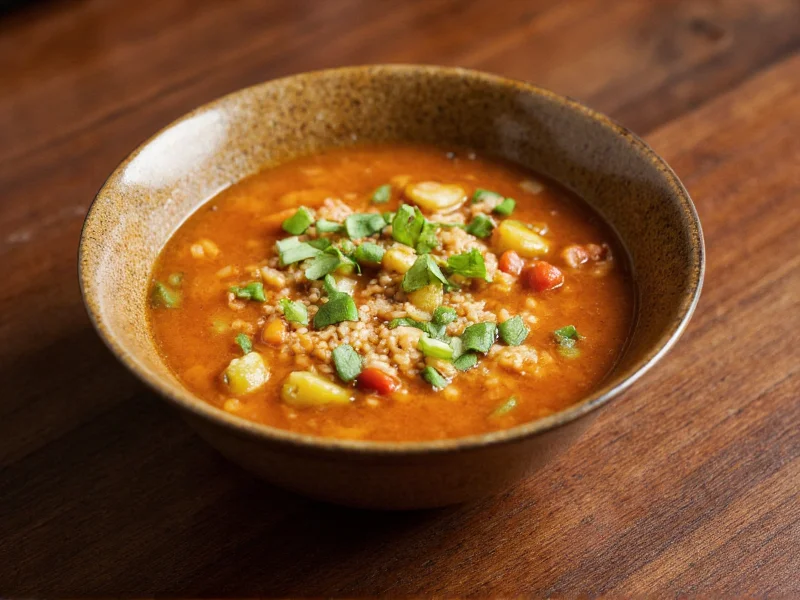Soup represents one of humanity's oldest culinary inventions, with evidence of soup-making dating back to approximately 20,000 BC. Archaeological findings in Xianrendong Cave, China, revealed pottery fragments containing residues from what appears to be an early form of soup. This simple preparation method emerged naturally as early humans discovered that boiling food in water made it more digestible and safer to consume.
The Essential Characteristics of Soup
While soup variations exist across cultures, certain elements consistently define what makes something a soup:
- Liquid foundation - Water, stock, or broth forms the base
- Heated preparation - Soup is almost always cooked through simmering or boiling
- Ingredient suspension - Solid components remain suspended in the liquid
- Consumption method - Typically eaten with a spoon from a bowl
These characteristics distinguish soup from similar preparations. For example, while stew contains similar ingredients, it has a much thicker consistency with less liquid (typically 50-60% liquid content) and the solid components form the primary focus of the dish.
Major Categories of Soup
Culinary professionals generally classify soups into several fundamental categories based on preparation method and ingredients:
| Soup Category | Key Characteristics | Common Examples |
|---|---|---|
| Clear Soups | Transparent broth with visible ingredients | Consommé, bouillon, Asian broths |
| Thick Soups | Thickened through roux, pureeing, or starches | Chowders, bisques, cream soups |
| Bouillon-Based | Flavorful broth as primary component | French onion soup, miso soup |
| Puree Soups | Blended ingredients creating smooth texture | Lentil soup, pumpkin soup, vichyssoise |
How Soup Differs from Similar Preparations
Many food preparations share similarities with soup but have distinct characteristics that differentiate them:
- Soup vs. Broth - Broth refers specifically to the liquid component of soup, while soup includes both the liquid and solid ingredients. Commercially labeled "broth" often contains more seasoning than stock.
- Soup vs. Stew - Stews have significantly less liquid (about half the volume of soup) and the solid ingredients constitute the main portion of the dish rather than being suspended in liquid.
- Soup vs. Sauce - Sauces serve primarily as accompaniments to other foods, while soup stands as a complete dish. Sauces also typically have much thicker consistency.
Cultural Variations in Soup Traditions
Every major culinary tradition has developed distinctive soup preparations that reflect local ingredients and cultural preferences:
- Asian traditions - Often feature clear broths with delicate flavors, like Japanese miso soup or Vietnamese pho, emphasizing umami rather than heaviness
- European traditions - Tend toward heartier preparations, from French bisques to Polish żurek (sour rye soup)
- African traditions - Frequently incorporate groundnuts (peanuts) and spices, as seen in West African groundnut soup
- American traditions - Range from New England clam chowder to Mexican tortilla soup, reflecting the country's diverse cultural influences
Nutritional Aspects of Soup
Soup offers several nutritional advantages that contribute to its enduring popularity:
- Hydration benefits from the high liquid content
- Concentrated nutrients from simmered ingredients
- Lower calorie density compared to many solid food preparations
- Enhanced digestibility of ingredients through cooking process
Research published in the journal Appetite suggests that consuming soup before a meal can reduce overall calorie intake by approximately 20%, making it a valuable component of balanced eating patterns. The slow simmering process also helps break down nutrients into more readily absorbable forms.
Modern Soup Innovations
Contemporary culinary approaches have expanded traditional soup definitions while maintaining core characteristics:
- Cold soups - Gazpacho and vichyssoise demonstrate that temperature doesn't define soup
- Deconstructed soups - Modern presentations that separate components while maintaining the essence
- Instant soup technology - Advances in freeze-drying preserve flavor and nutrition
- Global fusion soups - Combining elements from multiple culinary traditions
Despite these innovations, the fundamental definition remains consistent: soup must maintain that essential liquid foundation that allows ingredients to be suspended and consumed primarily with a spoon.
Conclusion: The Enduring Appeal of Soup
Soup's universal appeal across cultures and throughout history stems from its fundamental simplicity, adaptability, and nourishing qualities. From basic survival food to gourmet preparation, soup continues to evolve while maintaining its essential characteristics. Understanding what defines soup helps appreciate both its historical significance and its ongoing culinary relevance in kitchens worldwide.
What is the minimum liquid content for something to be considered soup?
Most culinary authorities consider that for a preparation to qualify as soup, it should contain at least 80% liquid content. This distinguishes soup from similar preparations like stews (which typically have 50-60% liquid) or sauces (which have even less liquid content).
Is gazpacho considered soup even though it's served cold?
Yes, gazpacho is absolutely considered a soup despite being served cold. Temperature doesn't determine whether something is soup; rather, it's the liquid foundation and preparation method. Gazpacho maintains the essential characteristics of soup with its blended vegetable base and liquid consistency.
How does consommé differ from regular broth?
Consommé is a clarified broth that has been carefully prepared to remove impurities, resulting in a crystal-clear liquid. Regular broth contains small particles and fats that give it a cloudy appearance. The clarification process for consommé involves using egg whites and ground meat to trap impurities as the broth simmers.
Can soup be thickened after preparation and still be considered soup?
Yes, soup can be thickened after preparation and still remain soup, as long as it maintains sufficient liquid content (typically at least 80%). Common thickening methods include roux, cornstarch slurry, pureeing some ingredients, or adding cream. The key is that the dish remains primarily liquid rather than becoming a solid preparation.
What's the difference between stock and broth in soup making?
Stock is made primarily from bones and connective tissue, resulting in a more gelatinous texture when cooled due to collagen extraction. Broth is made from meat and vegetables, creating a more immediately flavorful liquid. Many professional chefs use both in soup preparation, with stock providing body and broth contributing flavor.











 浙公网安备
33010002000092号
浙公网安备
33010002000092号 浙B2-20120091-4
浙B2-20120091-4